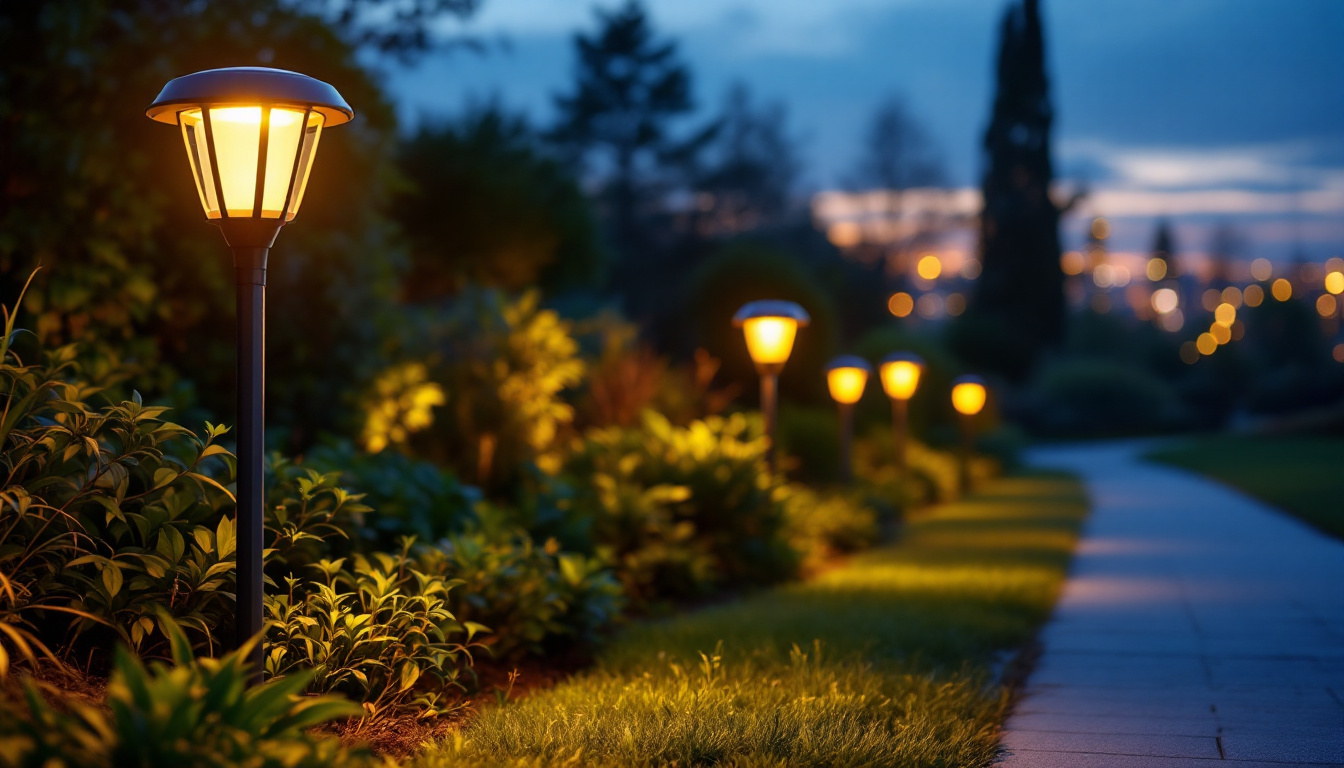

As outdoor spaces become increasingly important for homeowners, the demand for effective and sustainable lighting solutions has surged. Solar outdoor path lights have emerged as a popular choice, blending functionality with eco-friendliness. For lighting contractors, understanding the nuances of these lights is essential for providing clients with optimal solutions. This article aims to demystify solar outdoor path lights, offering insights into their benefits, installation considerations, and maintenance requirements.
Solar outdoor path lights are designed to illuminate walkways, gardens, and other outdoor areas using solar energy. These lights harness sunlight during the day and convert it into electricity, allowing them to operate without traditional wiring or electricity sources. This makes them an attractive option for both residential and commercial applications. Their versatility not only enhances the aesthetic appeal of outdoor spaces but also contributes to safety by providing clear visibility along pathways and driveways.
At the core of solar path lights is a photovoltaic (PV) cell, which captures sunlight and converts it into electrical energy. This energy is stored in rechargeable batteries, enabling the lights to function after sunset. Most solar path lights are equipped with light-emitting diodes (LEDs), which provide bright illumination while consuming minimal energy. The efficiency of these LEDs ensures that even in low-light conditions, the lights can still provide adequate brightness, making them a reliable choice for nighttime illumination.
When the sun sets, a built-in light sensor detects the change in light levels and activates the LEDs. The duration of illumination depends on the capacity of the batteries and the amount of sunlight collected during the day. Typically, well-designed solar path lights can provide several hours of light, making them suitable for nighttime use. Some advanced models even come with adjustable settings that allow users to customize the brightness and duration of light, providing flexibility based on specific needs or preferences.
There are numerous advantages to using solar outdoor path lights, making them an appealing choice for contractors and homeowners alike. Some of the key benefits include:
Additionally, solar path lights come in a variety of styles, materials, and designs, allowing homeowners to choose options that best match their outdoor décor. From sleek modern designs to more traditional lantern styles, there is a solar path light to suit every taste. Furthermore, many models are designed to be weather-resistant, ensuring durability and longevity even in harsh outdoor conditions. This resilience is particularly important for areas that experience extreme temperatures or heavy rainfall, making solar path lights a reliable choice for year-round use.
Moreover, the installation of solar path lights can enhance the security of a property. By illuminating dark areas, they deter potential intruders and provide peace of mind for homeowners. Some solar lights even come equipped with motion sensors, which can further enhance security by activating bright lights when movement is detected. This feature not only conserves energy by ensuring lights are only on when needed but also adds an extra layer of safety for families and guests navigating outdoor spaces at night.
While solar outdoor path lights offer numerous benefits, there are several factors that lighting contractors should consider when recommending or installing these lights. Understanding these aspects can help ensure that clients receive the best possible solutions for their outdoor lighting needs.
Before installation, conducting a thorough site assessment is crucial. Factors such as sunlight exposure, landscape features, and potential obstructions can significantly impact the performance of solar path lights. Areas that receive ample sunlight throughout the day are ideal for solar lighting, while shaded spots may result in inadequate charging and reduced illumination.
Contractors should evaluate the layout of the outdoor space, identifying key areas that require lighting. This includes pathways, steps, and other high-traffic zones. Proper placement ensures that the lights serve their intended purpose while enhancing the overall aesthetic of the landscape. Additionally, it is beneficial to consider the seasonal changes in sunlight exposure, as trees and foliage may grow or lose leaves, affecting light availability throughout the year.
Not all solar path lights are created equal. When selecting products for clients, contractors should consider several factors, including:
Moreover, contractors should also assess the design and aesthetics of the solar path lights. A wide range of styles, colors, and finishes are available, allowing for customization that complements the existing landscape and architecture. Selecting lights that harmonize with the outdoor decor can enhance the visual appeal and create a cohesive look. Additionally, energy efficiency ratings and warranty options are important considerations, as they can influence long-term satisfaction and performance reliability for clients.
Finally, it is essential to stay updated on the latest advancements in solar technology. Innovations such as smart solar lights that can be controlled via mobile apps or integrated with home automation systems are becoming increasingly popular. These features not only enhance convenience but also provide clients with greater control over their outdoor lighting, allowing them to adjust settings based on their preferences or specific occasions.
Proper installation is key to maximizing the effectiveness and longevity of solar outdoor path lights. Following best practices can help ensure that the lights perform optimally and meet client expectations.
When installing solar path lights, careful consideration should be given to their placement and spacing. Lights should be positioned to provide adequate illumination without creating harsh shadows or overly bright spots. A common guideline is to space lights approximately 6 to 8 feet apart, depending on the brightness and intended use.
In addition to spacing, the height at which lights are installed can affect their performance. Generally, path lights should be positioned at a height of 18 to 24 inches above the ground to ensure optimal visibility while also enhancing the landscape’s aesthetics.
After installation, it is essential to test the solar path lights to ensure they function as intended. This includes checking the brightness, duration of illumination, and overall performance. If any issues arise, adjustments may be necessary, such as repositioning lights or replacing batteries to enhance performance.
While solar outdoor path lights are generally low-maintenance, periodic checks and maintenance can help extend their lifespan and ensure optimal performance. Contractors should educate clients about the following maintenance practices.
Regular cleaning of solar path lights is crucial for maintaining their efficiency. Dust, dirt, and debris can accumulate on the solar panels, obstructing sunlight and reducing charging capacity. A simple wipe with a damp cloth can keep the panels clear and functioning effectively.
Additionally, contractors should recommend that clients inspect the lights periodically for any signs of wear or damage. This includes checking for cracked lenses, rust, or any other issues that may affect performance. Prompt repairs can prevent further damage and ensure the lights remain functional.
Despite their reliability, solar path lights may encounter issues from time to time. Common problems include:
As technology advances, the landscape of solar outdoor path lights continues to evolve. Staying informed about the latest trends can help lighting contractors offer cutting-edge solutions to their clients.
One of the most significant trends in solar path lighting is the integration of smart technology. Many modern solar lights now come equipped with features such as motion sensors, remote control capabilities, and connectivity to smart home systems. These advancements not only enhance convenience but also improve energy efficiency by allowing users to customize lighting schedules and settings.
Design plays a crucial role in outdoor lighting, and manufacturers are increasingly focusing on aesthetics. Solar path lights are now available in a wide range of styles, materials, and finishes, allowing contractors to offer clients options that complement their outdoor spaces. From sleek modern designs to rustic lantern styles, the variety ensures that there is something for every taste.
Solar outdoor path lights represent a sustainable and efficient lighting solution for a variety of outdoor applications. For lighting contractors, understanding the intricacies of these lights—from their operation and benefits to installation and maintenance—is essential for delivering exceptional service to clients. By staying informed about trends and best practices, contractors can position themselves as knowledgeable professionals in the ever-evolving landscape of outdoor lighting.
Ultimately, as homeowners increasingly prioritize sustainable solutions, solar path lights will continue to gain traction. By embracing this technology and providing clients with informed recommendations, lighting contractors can enhance their offerings and contribute to the growing demand for eco-friendly outdoor lighting solutions.
Ready to elevate your lighting projects with the most efficient and sustainable solar path lights on the market? At LumenWholesale, we provide lighting contractors like you with the highest quality, spec-grade lighting products at prices that can’t be beaten. Say goodbye to local distributor markups and hello to our extensive selection that meets rigorous industry standards. With free shipping on bulk orders, you can trust that you’re getting premium lighting at the best value — all without hidden fees or compromises. Enhance your service offerings and meet the growing demand for eco-friendly lighting solutions with ease. Visit LumenWholesale today and experience the perfect blend of quality, affordability, and convenience.

Discover why opting for local distributors when purchasing grow lights in bulk might not be the best decision.

Discover how metal halide high bay light fixtures can revolutionize your lighting projects by saving contractors both time and money.

Discover the key challenges lighting contractors face when converting fluorescent tubes to LED.

Discover the essentials of solar outdoor path lights in this comprehensive guide tailored for lighting contractors.
Get notified when NEW deals are released.
Optimize your budget with wholesale discounts.
Only top-quality, specification-grade lighting products.
No additional costs at checkout - what you see is what you pay.
We understand the unique needs of contractors.